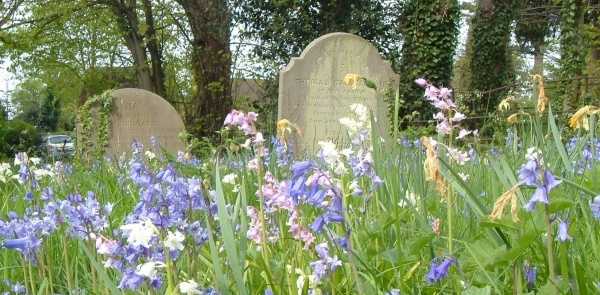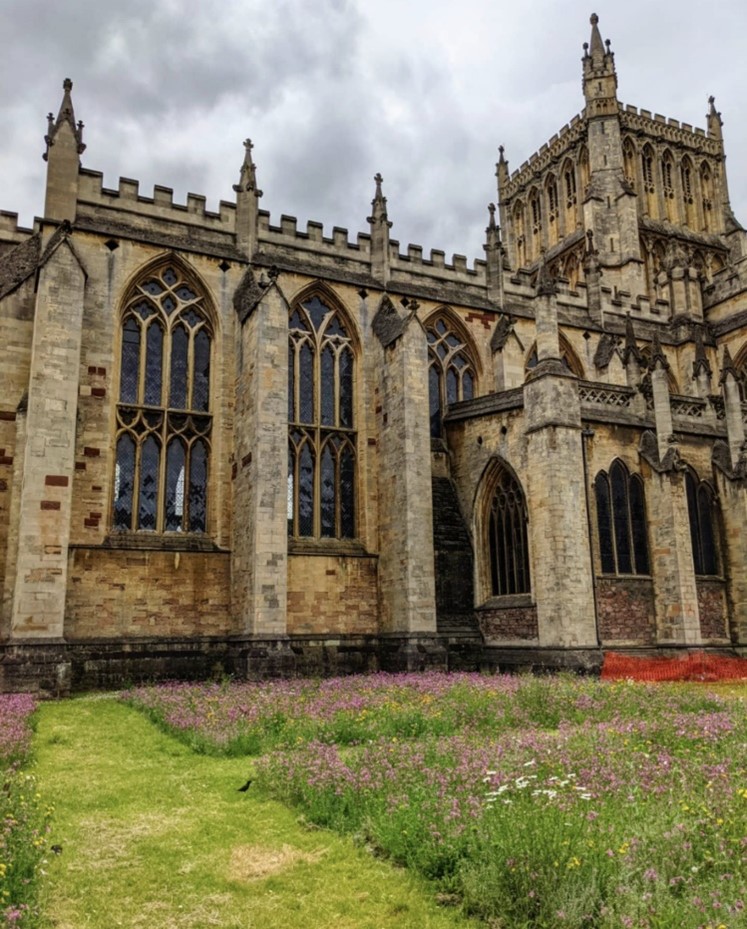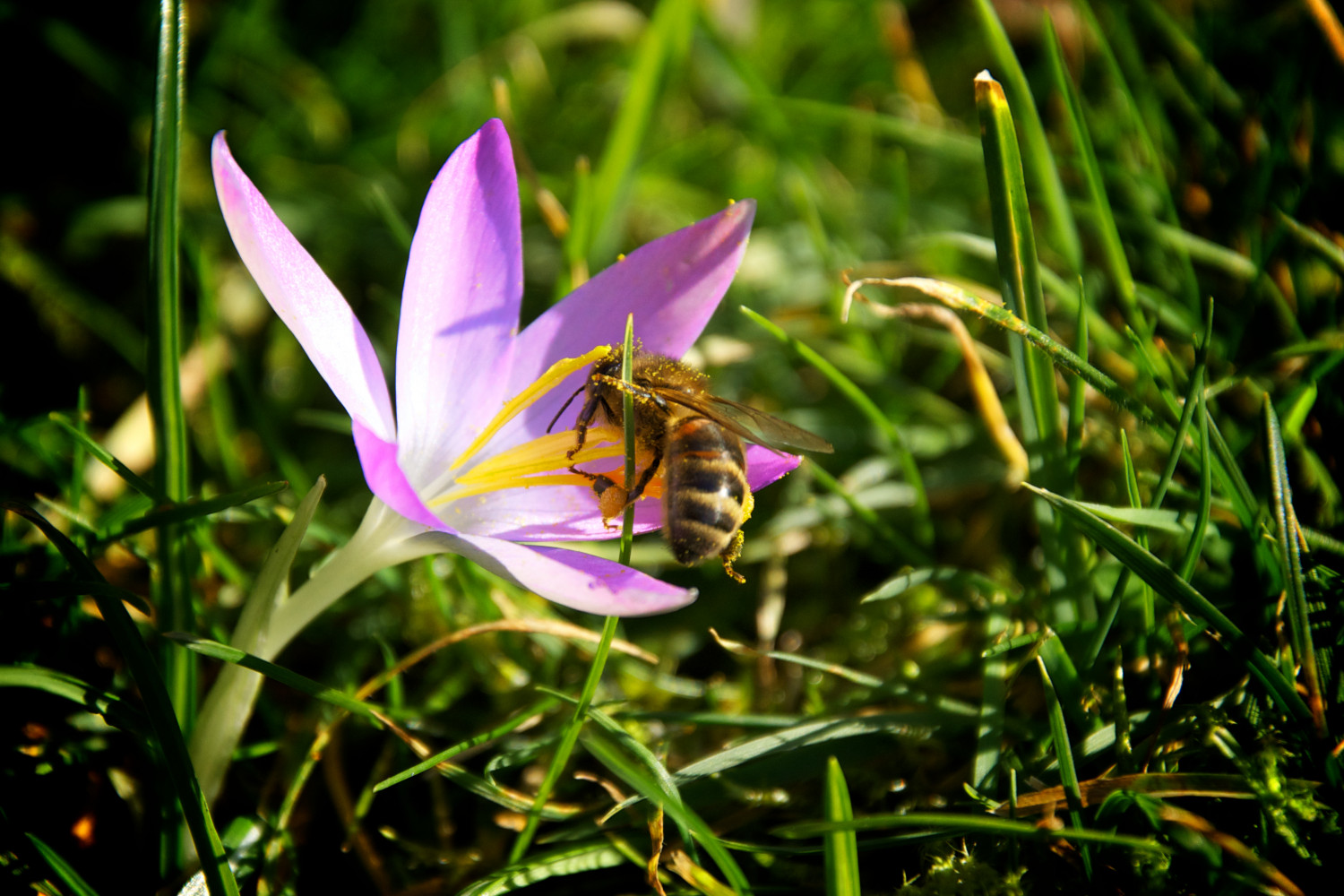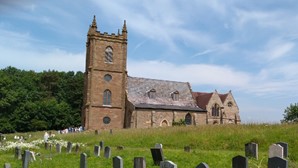
In this blog post, the diocesan Climate Crisis Group explains the benefits of keeping a wildflower area of your churchyard.
Mowing the grass around cathedrals and churches is a relatively modern practice. Before the invention of the lawn mower in 1830, and its adoption by Victorian gardeners, the ground would have been covered with diverse plants, managed by passing feet, cart tracks, cutting with a scythe and grazed by wild or domestic animals.
But now there is a move away from uniformly flat, green amenity spaces around iconic buildings and churches, and a growing trend for letting the grass grow. Wildflower seeds are often added as appropriate and the area becomes an attraction in its own right.
 During the pandemic a ‘large swathe of Cambridge's most iconic lawn was transformed into an ecosystem rich in biodiversity’ providing a beautiful, tranquil environment, for the King’s College community.’ King’s College not only demonstrated their care of God’s creation and their students, but have inspired others to do likewise by example and by selling wildflower seed packs.
During the pandemic a ‘large swathe of Cambridge's most iconic lawn was transformed into an ecosystem rich in biodiversity’ providing a beautiful, tranquil environment, for the King’s College community.’ King’s College not only demonstrated their care of God’s creation and their students, but have inspired others to do likewise by example and by selling wildflower seed packs.
This year, Bristol Cathedral has let its grass grow in a joint project with community organisations. The mown paths invite visitors to wonder around the wildflower areas (The meadow is pictured right). See more on their Twitter account.
Eco Church and letting the grass grow
A ‘letting the grass grow’ project would promote biodiversity, help reconnect people with nature, provide a focus for worship, education and campaigning, and act as a witness to the care Christians have for all of God’s creation. These purposes can all be found in the Eco Church online survey. The survey questions are in italics. See the full Eco Church survey.
Biodiversity (these survey items are from the Land section of the Eco Church survey)
2. The land at our church is managed for the encouragement of native wildlife (birds, animals and plants).
7. Our church maintains an area of land for native wildflowers.
8. Our church has researched and established a mowing regime appropriate to the conservation of the grassland and wildlife present.
 A shocking 97% of the UK's wild flower meadows have been lost since 1930, and 1 in 5 of all UK flowering plant species are threatened with extinction according to the RSPB. Up to 30% of the world’s carbon is stored in grasslands. The biodiversity crisis is inextricably linked to the climate crisis. Find out more. From a window box to a churchyard, every bit of extra habitat is important. Your church could register as part of a network of pollinator projects, a ‘B-line’. More details here.
A shocking 97% of the UK's wild flower meadows have been lost since 1930, and 1 in 5 of all UK flowering plant species are threatened with extinction according to the RSPB. Up to 30% of the world’s carbon is stored in grasslands. The biodiversity crisis is inextricably linked to the climate crisis. Find out more. From a window box to a churchyard, every bit of extra habitat is important. Your church could register as part of a network of pollinator projects, a ‘B-line’. More details here.
Reconnecting people and God's creation (these survey items are from the Land section of the Eco Church survey.)
15. Our church actively encourages members to use church land for recreation/contemplation (e.g. picnics, prayer etc.).
16. Our church actively encourages members of the local community to use the church land for recreation/contemplation.
Christian environmental charity, A Rocha aims to reconnect people, especially urban communities and children, with nature. If people feel a strong connection to nature, they are far more likely to care for and fight for nature.
Disconnection from nature is thought to increase mental and physical health problems. Many people feel close to God in natural surroundings but not in organised religions. Churches with green spaces have the opportunity to reach out to people who might not come to a service.
 Sadly, many people who care deeply about nature, do not see the church taking steps to care for it. Letting the grass grow is a sermon and prophetic witness that is visible to all the community.
Sadly, many people who care deeply about nature, do not see the church taking steps to care for it. Letting the grass grow is a sermon and prophetic witness that is visible to all the community.
Churches such as Hanbury are gaining a reputation as a venue for weddings. The long grass and wildflowers are very much a part of what they have to offer (visit their website).
Education and Witness (these survey items are from the Land section of the Eco Church survey.)
11. Our church undertakes wildlife (birds, animals and plants) surveys on our land.
12. Our church participates in a scheme, other than Eco Church, designed to promote conservation on church land (e.g. ‘Living Churchyards’)
 By registering with an organisation like ‘Caring for God’s Acre’, a church can receive support and advice about management, can take part in national surveys of wildlife, and add the details of their church for visitors, onto the website. Find out more
By registering with an organisation like ‘Caring for God’s Acre’, a church can receive support and advice about management, can take part in national surveys of wildlife, and add the details of their church for visitors, onto the website. Find out more
Communicating about a ‘letting the grass grow’ project in the church newsletter and by signage, keeps people informed about the progress, and what wildlife to look out for. Public expectations have changed now that wildflower areas are increasingly common. Councils have found that signage as simple as a picture of a bee, can be sufficient to explain why an area has not been mown. Visitors often look for information boards to help them identify species.
Campaigning (these survey items below are from the Community and Global Engagement section of the Eco Church survey.)
15. Our church participates in campaigns concerning national environmental issues.
16. Our church participates in campaigns concerning global environmental issues.
 Encouraging the members of your church to take part in the Grasslands Plus campaign, in the lead up to COP26, will raise awareness of the importance of grasslands not only for biodiversity but also in fighting climate change. Visit the website.
Encouraging the members of your church to take part in the Grasslands Plus campaign, in the lead up to COP26, will raise awareness of the importance of grasslands not only for biodiversity but also in fighting climate change. Visit the website.
10 top tips for a 'letting the grass grow' project
- Research and photograph similar local examples of ‘letting the grass grow’ and wildflower areas. It’ll help you think through the issues for your location and make it easier to explain the process.
- Listen to and address concerns. Hearing from someone who had been through the process might help, or go on site visits. Adapt your ideas to take concerns into consideration.
- Be clear about the purposes of the project and communicate these through your church communications and signage.
- If your grassed area is an historic site, letting grassland plants grow or adding wildflower seeds should not cause a problem by disturbing the ground too much. Signs could be added to existing structures rather than by digging in new posts.
- Look up advice such as on this website. If you already have five or more species of plant in your mowed grass area, you could simply let the plants grow before considering adding any wildflower seeds.
- Seeds can be collected from the project or from garden wildflower areas, in the summer and early autumn. Harvested seeds can be resown as required in the wildflower area. This project may well cost less than mowing.
- Surplus seed could be shared to encourage others to grow wildflowers, used in another area, or as a token of commitment in an act of worship.
- Remember this project is an experiment, which is exciting but it also flexible. It is possible to remove unwanted plants. This project is also easily reversible and can be adapted to suit the need to mow for particular events.
- Recruit someone to carry out a biodiversity survey. If there is no-one in your church, a local environmental organisation such as Worcestershire Wildlife Trust may be able to suggest someone.
- Explore the possibilities created by the project, such as outside worship, involving community organisations, the local press, children’s groups, sustainable flower arranging, environmental education and creative projects.

